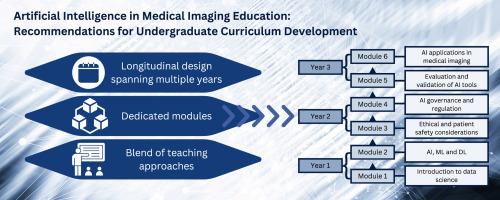医学影像教育中的人工智能:本科生课程开发建议。
IF 2.5
Q2 RADIOLOGY, NUCLEAR MEDICINE & MEDICAL IMAGING
引用次数: 0
摘要
目的:人工智能(AI)正在迅速融入医学影像实践,这促使人们呼吁在放射学本科课程中加强人工智能教育。本文结合文献证据、从业者见解和行业观点,为医学影像本科教育提供建议,包括课程修订和重新调整:本文概述了一个拟议的模块框架,以帮助课程提供者将人工智能纳入大学课程。课程设计范例包括数据科学基础、机器学习、人工智能伦理与患者安全、治理与监管、人工智能工具评估和临床应用等模块。建议在课程中纵向嵌入这些内容,并结合实践经验和工作综合学习,这将有助于培养必要的人工智能知识及其对现实世界的影响。真实的评估案例可以强化学习,如批判性地评估已发表的研究成果和反思当前的技术。要保持课程的与时俱进,需要教育工作者、临床医生和行业专业人士共同参与的多学科协作方法:将人工智能教育纳入医学影像本科课程,可使未来的放射技师在不断发展的技术环境中做好准备。在整个学位课程中嵌入人工智能模块的战略方法可确保学生全面了解人工智能原理、有效利用人工智能工具的技能以及批判性评估其影响的能力:人工智能本科教育的实际实施将使放射技师做好准备,在确保患者护理的同时融入这些技术。本文章由计算机程序翻译,如有差异,请以英文原文为准。

Artificial intelligence in medical imaging education: Recommendations for undergraduate curriculum development
Objectives
Artificial intelligence (AI) is rapidly being integrated into medical imaging practice, prompting calls to enhance AI education in undergraduate radiography programs. Combining evidence from literature, practitioner insights, and industry perspectives, this paper provides recommendations for medical imaging undergraduate education, including curriculum revision and re-alignment.
Key findings
A proposed modular framework is outlined to assist course providers in integrating AI into university programs. An example course design includes modules on data science fundamentals, machine learning, AI ethics and patient safety, governance and regulation, AI tool evaluation, and clinical applications. A proposal to embed these longitudinally in the curriculum combined with hands-on experience and work-integrated learning will help develop the necessary knowledge of AI and its real-world impacts. Authentic assessment examples reinforce learning, such as critically appraising published research and reflecting on current technologies. Maintenance of an up-to-date curriculum will require a collaborative, multidisciplinary approach involving educators, clinicians, and industry professionals.
Conclusion
Integrating AI education into undergraduate medical imaging programs equips future radiographers in an evolving technological landscape. A strategic approach to embedding AI modules throughout degree programs assures students a comprehensive understanding of AI principles, skills in utilising AI tools effectively, and the ability to critically evaluate their implications.
Implications for practice
The practical implementation of undergraduate AI education will prepare radiographers to incorporate these technologies while assuring patient care.
求助全文
通过发布文献求助,成功后即可免费获取论文全文。
去求助
来源期刊

Radiography
RADIOLOGY, NUCLEAR MEDICINE & MEDICAL IMAGING-
CiteScore
4.70
自引率
34.60%
发文量
169
审稿时长
63 days
期刊介绍:
Radiography is an International, English language, peer-reviewed journal of diagnostic imaging and radiation therapy. Radiography is the official professional journal of the College of Radiographers and is published quarterly. Radiography aims to publish the highest quality material, both clinical and scientific, on all aspects of diagnostic imaging and radiation therapy and oncology.
 求助内容:
求助内容: 应助结果提醒方式:
应助结果提醒方式:


